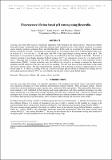| dc.contributor.author | Ryder, Alan G. | |
| dc.contributor.author | Power, Sarah | |
| dc.contributor.author | Glynn, Thomas J. | |
| dc.date.accessioned | 2016-10-20T17:37:46Z | |
| dc.date.available | 2016-10-20T17:37:46Z | |
| dc.date.issued | 2003 | |
| dc.identifier.citation | Ryder,A.G, Power,S, Glynn,T.J. (2003) 'Fluorescence lifetime based pH sensing using Resorufin' Proc SPIE - Int. Soc. Opt. Eng, 4876 :827-835. | en_IE |
| dc.identifier.isbn | 9780819446572 | |
| dc.identifier.uri | http://hdl.handle.net/10379/6085 | |
| dc.description | Conference paper | en_IE |
| dc.description.abstract | Accurate, non-contact pH sensing is of particular importance in the biological and clinical sciences. Fluorescence lifetime based pH sensing is potentially more useful than intensity based methods because of the reduced sensitivity to excitation source intensity variations, scattering effects, and photobleaching. In this work, we investigate the variation of fluorescence lifetime with pH for resorufin. The intensity averaged lifetime (τ) of resorufin sodium salt in 0.1M phosphate buffer shows an increase of > 3 ns over the 2 -10 pH range, with 90% of the signal change occurring between pH 4 and 8. The fluorescence is not quenched by chloride or oxygen and was unaffected by the ionic strength of the buffer. Resorufin is relatively insoluble in non-alkaline phosphate buffered solutions, but was estimated to increase by ~2 ns between pH 6 and 8. Resorufin and its sodium salt were both incorporated into sol-gels by either acid or base hydrolysis of tetra-methoxysilane (TMOS). Various surfactants were also added to the sol-gels in an attempt to optimise the fluorescence properties and pH sensitivity of the dyes, and to prevent cracking. The sols were then cast from petri-dishes or dip-coated onto acrylic and glass slides. The dyes retained their pH sensitivity, with showing an increase of approximately 2 ns over the pH range 6 - 8. However, leaching of the dye is observed at higher pH and attempt to minimise dye leaching and sol-gel cracking, poly(vinyl alcohol) (PVA) was cross-linked to the silica gel to form a more flexible matrix. | en_IE |
| dc.description.sponsorship | HEA; Millenium Research Fund (MF9/98/M); Enterprise Ireland (Research Innovation Fund Grant #IF/2001/061) | en_IE |
| dc.language.iso | en | en_IE |
| dc.relation.ispartof | Proc SPIE - Int. Soc. Opt. Eng. | en |
| dc.rights | Attribution-NonCommercial-NoDerivs 3.0 Ireland | |
| dc.rights.uri | https://creativecommons.org/licenses/by-nc-nd/3.0/ie/ | |
| dc.subject | Fluorescence | en_IE |
| dc.subject | Lifetime | en_IE |
| dc.subject | pH | en_IE |
| dc.subject | Sensors | en_IE |
| dc.subject | Sol-gel | en_IE |
| dc.subject | Resorufin | en_IE |
| dc.title | Fluorescence lifetime based pH sensing using Resorufin | en_IE |
| dc.date.updated | 2016-10-17T12:32:53Z | |
| dc.identifier.doi | 10.1117/12.463983 | |
| dc.local.publishedsource | http://dx.doi.org/10.1117/12.463983 | en_IE |
| dc.description.peer-reviewed | Not peer reviewed | |
| dc.contributor.funder | |~| | |
| dc.internal.rssid | 1158892 | |
| dc.local.contact | Alan Ryder, School Of Chemistry, Room 213, Arts/Science Building, Nui Galway. 2943 Email: alan.ryder@nuigalway.ie | |
| dc.local.copyrightchecked | No | |
| dc.local.version | SUBMITTED | |
| nui.item.downloads | 483 | |


